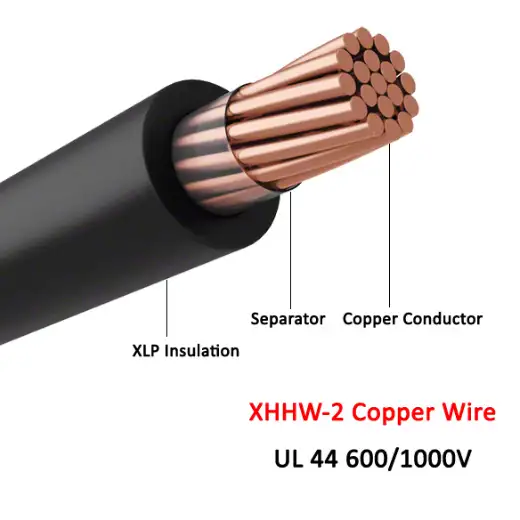If you’ve encountered electrical wiring labeled XHHW, you may wonder—what does XHHW stand for? This acronym identifies a common cross-linked polyethylene (XLPE) insulated, heat and water-resistant wire used in residential, commercial, and industrial applications. Known for durability and high voltage tolerance, XHHW cables meet key safety standards like UL 44 and NEC Article 310.

1. Introduction to XHHW Wire
XHHW wire is a type of electrical wire characterized by its cross-linked polyethylene (XLPE) insulation. This insulation provides enhanced thermal stability, chemical resistance, and mechanical strength, making XHHW wire suitable for a variety of demanding applications in both commercial and industrial settings.
2. Decoding the Acronym: XHHW
The acronym “XHHW” stands for:
-
X: Cross-Linked Polyethylene (XLPE) insulation
-
HH: High Heat-resistant
-
W: Water-resistant
This designation indicates that the wire is insulated with XLPE, offering high heat and water resistance, suitable for use in both dry and wet locations.
3. Insulation Material: Cross-Linked Polyethylene (XLPE)
XLPE is a thermoset polymer that undergoes a cross-linking process, enhancing its physical properties. This process improves the wire’s resistance to heat, chemicals, and physical stress, making it ideal for harsh environments.
4. Temperature and Environmental Ratings
XHHW wire is rated for:
-
90°C in both dry and wet locations
This rating ensures that the wire can operate safely under typical environmental conditions encountered in most installations.
5. Comparison with Other Wire Types
THHN vs. XHHW
| Feature | THHN | XHHW |
|---|---|---|
| Insulation Material | Thermoplastic PVC | Thermoset XLPE |
| Temperature Rating | 90°C (dry), 75°C (wet) | 90°C (dry and wet) |
| Water Resistance | Limited | High |
| Flexibility | Moderate | High |
| Cost | Lower | Higher |
THWN vs. XHHW
| Feature | THWN | XHHW |
|---|---|---|
| Insulation Material | Thermoplastic PVC with Nylon | Thermoset XLPE |
| Temperature Rating | 75°C (wet), 90°C (dry) | 90°C (dry and wet) |
| Water Resistance | High | High |
| UV Resistance | Moderate | High (if black insulation) |
| Cost | Lower | Higher |
XHHW vs. XHHW-2
| Feature | XHHW | XHHW-2 |
|---|---|---|
| Temperature Rating | 90°C (dry and wet) | 90°C (wet), 90°C (dry) |
| Voltage Rating | 600V | 600V/1kV |
| UV Resistance | Moderate | High (if black insulation) |
| Cost | Lower | Higher |
6. Applications of XHHW Wire
XHHW wire is commonly used in:
-
Commercial and Industrial Wiring: For power distribution and lighting systems.
-
Renewable Energy Systems: Due to its UV and water resistance.
-
Underground Installations: In conduits or direct burial applications.
-
Control Circuits: For HVAC and motor systems.
7. Industry Standards and Compliance
XHHW wire complies with various industry standards, including:
-
UL 44: Standard for Thermoset-Insulated Wires and Cables
-
NEC Article 310: National Electrical Code guidelines for wire installations
-
CSA C22.2 No. 38: Canadian standard for thermoset-insulated wires
These standards ensure the wire’s safety, performance, and suitability for specific applications.
8. Installation Best Practices
When installing XHHW wire:
-
Use Appropriate Conduits: To protect the wire from physical damage.
-
Follow NEC Guidelines: For spacing, grounding, and temperature ratings.
-
Avoid Overloading Circuits: To prevent overheating and potential hazards.
9. Maintenance and Troubleshooting
Regular maintenance includes:
-
Inspecting for Physical Damage: Check for cuts, abrasions, or signs of wear.
-
Testing Continuity: Ensure there are no breaks or faults in the wire.
-
Monitoring Temperature: Ensure the wire operates within its rated temperature range.
Troubleshooting involves identifying and addressing issues such as:
-
Overheating: Caused by overloading or poor ventilation.
-
Corrosion: Due to exposure to chemicals or moisture.
-
Physical Damage: From improper handling or installation.
10. Frequently Asked Questions (FAQs)
10.1 What is the difference between XHHW and THHN wire?
XHHW wire uses thermoset XLPE insulation, offering higher heat and water resistance compared to THHN’s thermoplastic PVC insulation. XHHW is suitable for both dry and wet locations, while THHN is limited to specific conditions.
10.2 Can XHHW wire be used outdoors?
Yes, XHHW wire is suitable for outdoor applications, especially when black insulation is used, as it offers UV resistance.
10.3 Is XHHW wire suitable for underground installations?
XHHW wire is suitable for underground installations when placed in conduits or direct burial applications, provided it meets local code requirements.
10.4 What is the voltage rating of XHHW wire?
XHHW wire is typically rated for 600V applications. However, XHHW-2 variants may have higher voltage ratings.
10.5 Can XHHW wire be used in residential wiring?
Yes, XHHW wire can be used in residential wiring, especially for outdoor or underground applications.
10.6 How does XHHW compare to XHHW-2?
XHHW-2 offers a higher voltage rating (600V/1kV) and improved UV resistance compared to standard XHHW wire.
11. Conclusion
XHHW wire, with its cross-linked polyethylene insulation, offers enhanced heat and water resistance, making it suitable for a wide range of applications. Understanding its properties and comparing it with other wire types like THHN and THWN can help in selecting the appropriate wire for specific needs.

